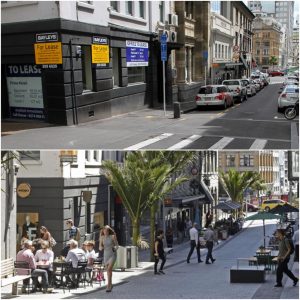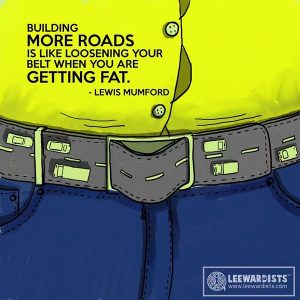Let’s Get Wellington Moving 3: Planning For Our Future!* (*in goldfish years)
In our third of three substantive posts, Talk Wellington looks at Let’s Get Wellington Moving’s approach to moving Wellington’s imminently burgeoning population. First: some city transport basics. Then: LGWM… and goldfish time.
City basics 1: Wellington City’s population is projected to keep growing.
A lot. This means opportunities and challenges for the city.
Opportunities: more people living, playing, working means more of those great city phenomena: more diverse city culture, richer and deeper markets (for everything from food to services to public transport to commercial space); more urban life; better safety…
Challenges: where all the the sewage and stormwater goes; urban green space; cultivating community; managing demand for beaches; minimising harm to people from earthquakes…
City basics 2: big challenge = how all those people move around.
Let’s Get Wellington Moving is setting out to tackle this challenge. We at TalkWellington welcome their intent and principles with enthusiastic Hurrahs, but have some serious concerns.
More on this below, but first – a quick reminder of why this matters.
Movement or destination – what are city spaces for?

O’Connell Street, Auckland. Before, optimising for transport. After, optimising for destination. (Click to enlarge) Photo: Greater Auckland
People and goods need to move, but movement can quickly conflict with and undermine place – i.e. destination. Destination activities are what we do once we’re done moving. The shopping, eating, meeting, drinking, socialising, learning, playing, working that we do at our destination.
(Check out the difference between optimising for transport or movement, or optimising for place – picture to the right.)
For densely-used inner city land, where we want to optimise for “destination” activity, efficiency of transport must be the overriding test. So any city leaders’ mantra should be: get the most people (hearts, minds and wallets) where they want to be within the city, whenever they need, with the minimum impact on what’s around them.
Mass transit is the most efficient way to move people quickly for non-walkable city distances. All the other ways to move people over those short-to-medium city trips are deeply inefficient and undermine place – the destinations – in addition to being bad for the environment and our health.
Mass transit isn’t a silver bullet: it must be part of a whole system: walking, scooting, cycling, private cars, suburban busses, passenger trains, freight by road and by rail. But for moving the greatest numbers of hearts, minds and wallets about within a city, mass transit can’t be beaten. And for geographically constrained CBDs like Wellington’s, this should have been the transport mantra for decades.
Dozens of the great cities, large and small, that we admire are minimising people’s use of private cars in their dense hearts, giving people convenient, pleasant mass transit (and active travel) choices. Dozens of American cities are pushing back the once-hailed highways from the city centres, reclaiming (at vast expense) land for productive activity and efficient transport. They are acknowledging efficient transport’s power to move people and allow a pleasant, economically lively city, and starting to acknowledge the futility of building our way out of congestion.
City basics 3: population density + mass transit = good city.
So far, so predictable.
But plot twist! Enter the Let’s Get Wellington Moving timeframe…
Some people know this stuff better than anyone: transport planners and transport economists, like those on the Let’s Get Wellington Moving team. These are the expert folks charged with sorting out transport from Ngauranga to the Airport. They acknowledge the scope cutoff at Ngauranga is a handicap, especially given all the induced demand from the big new roads beyond the scope line, and Project Director Barry Mein has said repeatedly “Nobody thinks we can build our way out of congestion with more road capacity”.
So… it was somewhat of a “plot twist”/ startling to open up the scenarios document and see, down the bottom of the multi-criteriate analysis:
“Assessment based on expected conditions in 2026”
That’s nine years away.
It’ll take five years just to complete planning and consenting. Let alone procurement, tendering and so forth. (Is someone going to attempt special enabling legislation?)
But crucially, transport infrastructure on this scale shapes cities for decades and decades after. Good practice is to look forward at the effects for at least a few decades. Auckland’s version of this initiative had a 30-year assessment, which isn’t long in the trade.
LGWM are calling this future planning, but it seems some people have very short time horizons.

But even a goldfish could see population density begging mass transit:
“Current growth rates for the city suggest the point at which demand would justify mass transit is about ten years away”
Yet there’s the $1.9 – $2.3 billion All The Things scenario, giving us
- Mass transit provided for by… wider roads and more tunnels, which are being touted as “easing congestion” and “fixing the bottlenecks” – i.e. more space for private cars
- And
- at best a 3-4% reduction in cars in the CBD during the morning peak (such a small amount it’ll be lost in the natural variation)
- increased traffic on SH1 through the city (“but less congested” – bless, maybe that’s why the nine years)
- “Could include light rail” on each little Mass Transit label – yet not even the basic preparatory works included in the $2.3 billion.
And we’re confidently guessing that there’ll be no new “mass transit” buses within at least ten years given GWRC’s recent contracting of the bus fleet and other statements.

So one’s compelled to ask: hey, smart LGWM transport planners, what’s going on here?
Surely you didn’t choose this goldfish-worthy time horizon because that was the only way to possibly show some (initial) decreases in congestion … while you’re basically force-feeding Wellington’s roads and buying the city bigger pants?
If you also think this is a bit daft, do tell them so. You can give feedback til 15th December. Quick!
Be tactical: remember they’re wanting a sense of the citizenry’s appetite for an approach to solving Wellington’s transport and liveability problems. It’s not a consultation – they just want a steer.
Remember also “fix the problem with more of the same” (bigger pants) is being pushed by lots of The Establishment, who should know better. So strongly progressive feedback will be important.
If you’ve no time to enjoy all of their beautifully designed website, and trust Talk Wellington (and every other progressive transport group):
- Click to here
- Tick “Scenario A”,
- Ignore the silly wording on “How far would you go?” because it’s a question of priority not “either/or”, and getting a general sense of appetite from the Wellington public. It’s not a consultation.
- Write in the freetext box your own version of “prioritise mass transit, and set some meaningful targets for decreasing private cars in the city.”
- Feeling keen? You could add something like “we can’t sort out transport without looking regionally”.
- Done! Spread the word – get your friends doing their 2 min too.
- Then treat yourself – you’ve just done a good thing.
Other reading:
Talk Wellington’s pt 1:Baby-stepping, maybe sideways
Talk Wellington’s pt 2:Voices from the Lands Out Of Scope
Congestion Free Wellington / FIT Wellington’s Scenario A+ proposal
Additional image credits:
Goldfish (silent): ぱたごん (Own work) [CC BY-SA 3.0 (https://creativecommons.org/licenses/by-sa/3.0)], via Wikimedia Commons
O’Connell Street, Auckland before / after: ohyesmelbourne and Patrick Reynolds, via Greater Auckland
Leave a comment